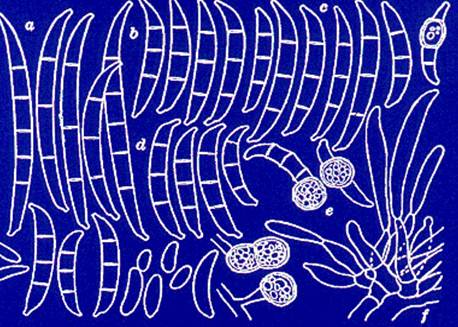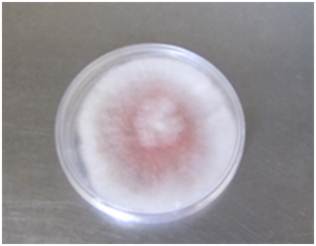

The causal agent of Fusarium wilt of bananas is called Fusarium oxysporum f. sp. cubense (Foc), a soil-inhabiting filamentous fungus thatbelongs to the section Elegans in the genus Fusarium. In culture, Foc can produce a surprizing range of colours, textures and aromas, but nothing that distinguishes the banana pathogen from F. oxysporum causing disease to other crops. On potato dextrose agar, colony morphology can range from sparse to cottony growth and the colour from deep purple to cream to peach. Certain members of Foc are able to produce volatiles and a star-like growth. The fungus produces three spore types, which include: macroconidia, microconidia and chlamydospores.
The macroconidia are nearly straight, slender and thin-walled with three to four septa, a foot-shaped basal cell and a curved tapered apical cell. They are produced from short phialides on conidiophores. Microconidia are one- or two celled, oval- to kidney-shaped and are produced in false heads. Chlamydospores are usually globose and are formed singly or in pairs in hyphae or conidia. They are resistant to desiccation and unfavourable environmental conditions, and enable the fungus to survive for more than 30 years in the soil after their host has been removed. In the presence of roots, chlamydospores or conidia germinate and penetrate susceptible plants.
Based on pathogenicity to different banana cultivars, three races of Foc have been recognized. Race 1 causes disease in the 'Gros Michel' (AAA) and 'Silk' (AAB) cultivars. Race 2 attacks 'Bluggoe' (ABB), and race 4 infects Cavendish (AAA) cultivars and all the cultivars that are susceptible to race 1 and 2. Race 3 has been omitted as a pathogen of banana, as it attacks Heliconia spp. only. Substantial variation exists within Foc as measured by vegetative compatibility, volatile production, electrophoretic karyotyping and various molecular techniques. Twenty-one vegetative compatibility groups (VCGs) have been identified from a worldwide collection of Foc isolates. In South Africa, only one of these VCG's has been found, namely VCG 0120.
Foc is believed to have co-evolved with its Musa hosts in Southeast Asia and from there it was introduced into new banana-producing countries by the movement of infected planting material. In a study of a global collection of Foc, two major groups were identified based on electrophoretic karyotype; one group generally associated with banana cultivars with partial B genomes (i.e. at least one chromosome derived from M. balbisiana; e.g. Lady finger AAB and Bluggoe ABB), and the other associated with banana cultivars with pure A genomes (i.e. all chromosomes derived from M. acuminata; e.g. Cavendish AAA and Gros Michel AAA). These groups were confirmed with RFLP data, RAPD and DAF analysis, sequence analysis of the TEF and mtSSU genes and AFLP analysis. The two groups are evidence for independent evolutionary origins of Foc in Southeast Asia. One VCG of Foc (VCG 01214), however, may have originated outside the Indo-Malayan region. Isolates of this VCG affect ABB cooking bananas in northern Malawi, and are genetically distinct from other Foc lineages/VCGs. Foc isolates are further divided into distinct lineages with clusters of closely related VCGs, even when they are distributed over a broad geographic area. These relationships have been documented with RAPDs, RFLPs, AFLPs, electrophoretic karyotypes and multi-gene phylogenies, and suggest a clonal reproductive strategy for this pathogen.

